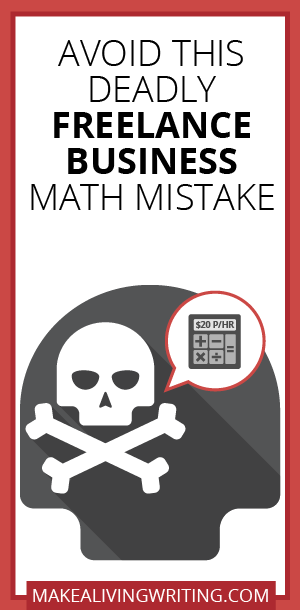
-Carol
A lot of writers aren’t good at math.
When I say that, I don’t just mean that we didn’t get an “A” in algebra back in high school. Or that a lot of writers don’t want to take article assignments that require heavy number-crunching.
When it comes to running a freelance business, many new writers don’t understand how to set a rate that will keep their freelance ship afloat. And by the time you find out, it may be too late.
Want to know how to avoid the deadly math mistake that can ruin your freelance business? Here’s what you need to know:
An exciting opportunity or ticket to starvation?
Here’s an example of what I’m talking about. I frequently see comments here on the blog along the lines of:
“I just got a client I’m excited about — they pay $20 an hour, which is more than I used to get working a day job.”
And that’s where it all goes wrong.
I don’t want to rain on this excited new freelance writer’s parade, but there’s something she hasn’t figured out about this gig.
This isn’t an exciting opportunity — it’s a ticket to starvation. It’s a step down the road to having to give up the freelance dream and get a day job again, because you’re flat broke.
The flaw in your calculations
Here’s the big issue: Your freelance hourly rate and your day-job hourly rate are not comparable figures.
They do not relate to each other. They are not similar.
This is not an apples-to-apples comparison. Which means it’s a bad comparison to make. One that gives you a false sense of well-being and sets you up for failure.
To find out whether your freelance hourly rate is truly better than your day job hourly, you have to do two things:
- Analyze all the components of your full-time job pay package
- Calculate all the items you have to pay for as a freelancer that you didn’t as a staffer
Anatomy of a paycheck
For an example, let’s compare my previous life as a staff writer with the life I now enjoy as a freelancer.
My staff job included:
- 40 predictable hours of pay
- Paid healthcare
- Paid vacation, personal days, and sick time
- Company-paid disability and life insurance
- Company matching on a 401(k) plan worth several thousand dollars a year
- Company paid 50% of my employment tax
- Annual transportation reimbursement plus free use of a company Flexcar for remote interviews
- Paid professional development/training/conferences
- Free break room coffee/snacks/meeting lunches
- Per diem budget for taking sources to lunch
- Fairly predictable annual raises
- Computer equipment, Internet, heat and light all provided during working hours
- Leave time for childbirth or caring for an ill relative under FMLA.
I used every one of these perks, by the way, including taking FMLA leave when we adopted our second child.
It’s easy to forget about all these juicy little perks that come with having a full-time job when you’re doing that freelance math, hmm?
Anatomy of a freelance expense sheet
When you are a freelancer, a whole raft of expenses and challenges land in your lap. Some of the ones that have definitely impacted my hourly rate calculations include:
- Health care (for those of us in the US & some other countries) — I pay nearly $8,000 a year for a family of five with a $7,500 deductible
- Equipment (that computer will break at some point or need replacing)
- Transportation
- Pay for your own training and conferences
- No paid vacation or sick time
- No federally required or paid leave time
- Pay my own disability and life insurance
- Pay 100% of my self-employment tax
- Billable hours are variable, and not every work hour can be billed
- Administrative and marketing time is unpaid
- No guaranteed raises
- Additional utilities costs from working from home
What you really need to make
After reviewing these figures, you may get a better sense of why I advocate that freelancers aim to make $100 an hour in order to build a sustainable business.
But every writer’s goals and cost of living are different.
Some of you have national healthcare, for instance. Or your spouse has a job and you can get covered for cheap on their plan. And you don’t need to earn as much because you’re not the primary breadwinner.
Some of us live in more expensive parts of the world, others less so. And our families come in different shapes and sizes.
We may be choosing to freelance part time, or be willing to put in 60 hours a week.
How can you determine what your target hourly rate should be?
Do the math. The real math, that takes freelance realities into account.
I recommend using a tool like this freelance rate calculator to plug in your own numbers and figure out your needed hourly rate.
Don’t assume you’re doing great because you’ve billed a few hours at a higher rate than you made in a full-time job. That could be faulty math that empties your bank accounts over time.
What’s your hourly rate? Leave a comment and tell us if that rate is working for you.










